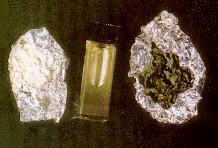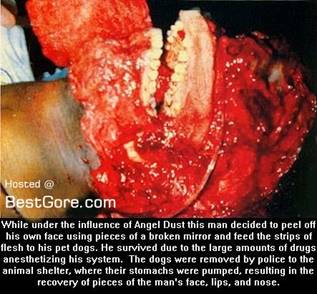 One of the most famous intravenous drugs for generating stories about bizarre behavior was phencyclidine: "angel dust," or "PCP." Although little is heard anymore about angel dust, it was well known for its ability to both addle and confer superhuman powers upon its abusers, or so the stories went. Tales of "some guy who was dusted" going berserk and beating up six cops before fifteen more managed to subdue him abounded. In my work in the [New York General Hospital], I witnessed some exceedingly strange dust-induced behavior, including one patient who’d done the most bizarre thing to himself I’d ever seen or heard of in my life.
One of the most famous intravenous drugs for generating stories about bizarre behavior was phencyclidine: "angel dust," or "PCP." Although little is heard anymore about angel dust, it was well known for its ability to both addle and confer superhuman powers upon its abusers, or so the stories went. Tales of "some guy who was dusted" going berserk and beating up six cops before fifteen more managed to subdue him abounded. In my work in the [New York General Hospital], I witnessed some exceedingly strange dust-induced behavior, including one patient who’d done the most bizarre thing to himself I’d ever seen or heard of in my life.
This man smoked dust one day and surprised his friends by politely excusing himself to the bathroom, bringing along his two Doberman pinschers. In the bathroom he opened the medicine cabinet, removed a straightedge razor, cut off his own facial features one by one, and fed them to his dogs. He emerged from the bathroom with no ears, nose, eyelids, lips, or cheeks, and two happy-looking dogs.
His friends, now fairly distraught, brought him to the NYG emergency room, where the plastic and head and neck surgeons pissed in their pants with excitement. They took him straight to the operating room. Jokes emerged immediately. The man lost face, the surgeons tried to save face, etc., etc.
In order to create a new face for this unfortunate patient, the surgeons did a "pectoral flap," a fascinating procedure in which the pectoral (chest) muscle is removed and reimplanted at another site on a patient’s body. The surgeon’s don’t remove the muscle completely, but leave intact his main artery and vein. The muscle is then "flapped" to the spot where it’s needed, presumably a hole that is too deep to be filled by mere skin grafting, and sewn in place. Eventually, it grows a new blood supply at the transplant site and the surgeons remove the original artery and vein. The man with no face had two pectoral flaps done, one from each side of his chest to each side of his face. Once the muscles were well established in their new locations the surgeons took him back to the OR about two hundred times to cut and shape and revise the graft to create a new face for him.
I know the story of the man with no face is true because I saw him walking down the hall a few weeks after he was admitted. He was wearing a surgical hood turned back in front, with two holes cut out for his eyes, like the "elephant man."
 Robert Stuart from Belleville IL
Robert Stuart from Belleville IL

